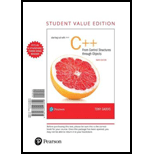
Starting Out with C++ from Control Structures to Objects, Student Value Edition (9th Edition)
9th Edition
ISBN: 9780134443829
Author: Tony Gaddis
Publisher: PEARSON
expand_more
expand_more
format_list_bulleted
Concept explainers
Question
Chapter 21, Problem 22RQE
Program Plan Intro
Binary tree:
- It is a tree data structure which comes under hierarchical data structure.
- It is made of nodes that have a left child, right child and a data element.
Nodes in a binary tree:
- The node which is at the top of a binary tree is called “root node”.
- The element that has children is known as “parent node”.
- The element that is under an element is known as “children”.
- The element or the node that has two children is called “leaves” or “external nodes”.
- In binary tree, each node should have at most two children.
Expert Solution & Answer
Want to see the full answer?
Check out a sample textbook solution
Students have asked these similar questions
Resolver por superposicion
Describe three (3) Multiplexing techniques common for fiber optic links
Could you help me to know features of the following concepts:
- commercial CA
- memory integrity
- WMI filter
Chapter 21 Solutions
Starting Out with C++ from Control Structures to Objects, Student Value Edition (9th Edition)
Ch. 21.1 - Prob. 21.1CPCh. 21.1 - Prob. 21.2CPCh. 21.1 - Prob. 21.3CPCh. 21.1 - Prob. 21.4CPCh. 21.1 - Prob. 21.5CPCh. 21.1 - Prob. 21.6CPCh. 21.2 - Prob. 21.7CPCh. 21.2 - Prob. 21.8CPCh. 21.2 - Prob. 21.9CPCh. 21.2 - Prob. 21.10CP
Ch. 21.2 - Prob. 21.11CPCh. 21.2 - Prob. 21.12CPCh. 21 - Prob. 1RQECh. 21 - Prob. 2RQECh. 21 - Prob. 3RQECh. 21 - Prob. 4RQECh. 21 - Prob. 5RQECh. 21 - Prob. 6RQECh. 21 - Prob. 7RQECh. 21 - Prob. 8RQECh. 21 - Prob. 9RQECh. 21 - Prob. 10RQECh. 21 - Prob. 11RQECh. 21 - Prob. 12RQECh. 21 - Prob. 13RQECh. 21 - Prob. 14RQECh. 21 - Prob. 15RQECh. 21 - Prob. 16RQECh. 21 - Prob. 17RQECh. 21 - Prob. 18RQECh. 21 - Prob. 19RQECh. 21 - Prob. 20RQECh. 21 - Prob. 21RQECh. 21 - Prob. 22RQECh. 21 - Prob. 23RQECh. 21 - Prob. 24RQECh. 21 - Prob. 25RQECh. 21 - Prob. 1PCCh. 21 - Prob. 2PCCh. 21 - Prob. 3PCCh. 21 - Prob. 4PCCh. 21 - Prob. 5PCCh. 21 - Prob. 6PCCh. 21 - Prob. 7PCCh. 21 - Prob. 8PC
Knowledge Booster
Learn more about
Need a deep-dive on the concept behind this application? Look no further. Learn more about this topic, computer-science and related others by exploring similar questions and additional content below.Similar questions
- Briefly describe the issues involved in using ATM technology in Local Area Networksarrow_forwardFor this question you will perform two levels of quicksort on an array containing these numbers: 59 41 61 73 43 57 50 13 96 88 42 77 27 95 32 89 In the first blank, enter the array contents after the top level partition. In the second blank, enter the array contents after one more partition of the left-hand subarray resulting from the first partition. In the third blank, enter the array contents after one more partition of the right-hand subarray resulting from the first partition. Print the numbers with a single space between them. Use the algorithm we covered in class, in which the first element of the subarray is the partition value. Question 1 options: Blank # 1 Blank # 2 Blank # 3arrow_forward1. Transform the E-R diagram into a set of relations. Country_of Agent ID Agent H Holds Is_Reponsible_for Consignment Number $ Value May Contain Consignment Transports Container Destination Ф R Goes Off Container Number Size Vessel Voyage Registry Vessel ID Voyage_ID Tonnagearrow_forward
- I want to solve 13.2 using matlab please helparrow_forwarda) Show a possible trace of the OSPF algorithm for computing the routing table in Router 2 forthis network.b) Show the messages used by RIP to compute routing tables.arrow_forwardusing r language to answer question 4 Question 4: Obtain a 95% standard normal bootstrap confidence interval, a 95% basic bootstrap confidence interval, and a percentile confidence interval for the ρb12 in Question 3.arrow_forward
- using r language Obtain a bootstrap t confidence interval estimate for the correlation statistic in Example 8.2 (law data in bootstrap).arrow_forwardusing r language Compute a jackknife estimate of the bias and the standard error of the correlation statistic in Example 8.2.arrow_forwardusing r languagearrow_forward
arrow_back_ios
SEE MORE QUESTIONS
arrow_forward_ios
Recommended textbooks for you
- Programming Logic & Design ComprehensiveComputer ScienceISBN:9781337669405Author:FARRELLPublisher:Cengage
 C++ Programming: From Problem Analysis to Program...Computer ScienceISBN:9781337102087Author:D. S. MalikPublisher:Cengage Learning
C++ Programming: From Problem Analysis to Program...Computer ScienceISBN:9781337102087Author:D. S. MalikPublisher:Cengage Learning Systems ArchitectureComputer ScienceISBN:9781305080195Author:Stephen D. BurdPublisher:Cengage Learning
Systems ArchitectureComputer ScienceISBN:9781305080195Author:Stephen D. BurdPublisher:Cengage Learning  C++ for Engineers and ScientistsComputer ScienceISBN:9781133187844Author:Bronson, Gary J.Publisher:Course Technology Ptr
C++ for Engineers and ScientistsComputer ScienceISBN:9781133187844Author:Bronson, Gary J.Publisher:Course Technology Ptr New Perspectives on HTML5, CSS3, and JavaScriptComputer ScienceISBN:9781305503922Author:Patrick M. CareyPublisher:Cengage Learning
New Perspectives on HTML5, CSS3, and JavaScriptComputer ScienceISBN:9781305503922Author:Patrick M. CareyPublisher:Cengage Learning EBK JAVA PROGRAMMINGComputer ScienceISBN:9781337671385Author:FARRELLPublisher:CENGAGE LEARNING - CONSIGNMENT
EBK JAVA PROGRAMMINGComputer ScienceISBN:9781337671385Author:FARRELLPublisher:CENGAGE LEARNING - CONSIGNMENT

Programming Logic & Design Comprehensive
Computer Science
ISBN:9781337669405
Author:FARRELL
Publisher:Cengage

C++ Programming: From Problem Analysis to Program...
Computer Science
ISBN:9781337102087
Author:D. S. Malik
Publisher:Cengage Learning

Systems Architecture
Computer Science
ISBN:9781305080195
Author:Stephen D. Burd
Publisher:Cengage Learning

C++ for Engineers and Scientists
Computer Science
ISBN:9781133187844
Author:Bronson, Gary J.
Publisher:Course Technology Ptr

New Perspectives on HTML5, CSS3, and JavaScript
Computer Science
ISBN:9781305503922
Author:Patrick M. Carey
Publisher:Cengage Learning

EBK JAVA PROGRAMMING
Computer Science
ISBN:9781337671385
Author:FARRELL
Publisher:CENGAGE LEARNING - CONSIGNMENT